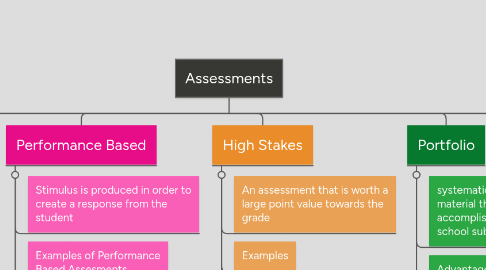
1. Formative
1.1. The goal of formative assessment is to monitor student learning to provide ongoing feedback that can be used by instructors to improve their teaching and by students to improve their learning. More specifically, formative assessments
1.2. Examples of Formative Assessments
1.2.1. Observations
1.2.2. Short worksheets
1.3. Advantages
1.3.1. Teacher sees student progress
1.3.2. Teacher can aide the student in the area where they are lacking
1.4. Disadvantages
2. Performance Based
2.1. Stimulus is produced in order to create a response from the student
2.2. Examples of Performance Based Assesments
2.2.1. Essay questions
2.2.2. Multiple Choice
2.3. Advantages
2.3.1. Students are engaged in the learning
2.4. Disadvantages
2.4.1. May not reflect all of students knowledge
3. Portfolio
3.1. systematic collection of student work and related material that depicts a student's activities, accomplishments, and achievements in one or more school subjects.
3.2. Advantages
3.2.1. Promotes self evaluation and reflection
3.2.2. Grading is based on genuine samples of students work
3.3. Disadvantages
3.3.1. Bulky and hard to store
3.3.2. Time consuming to grade
4. Summative
4.1. The goal of summative assessment is to evaluate student learning at the end of an instructional unit by comparing it against some standard or benchmark.
4.2. Examples of Formative Assessments
4.2.1. Midterms
4.2.2. Final Projects
4.3. Advantages
4.3.1. Assessment can be graded quickly
4.4. Disadvantages
4.5. May not reflect students actual progress/ knowledge
5. High Stakes
5.1. An assessment that is worth a large point value towards the grade
5.2. Examples
5.2.1. Tests/exams
5.3. Advantages
5.3.1. Results are instant
5.4. Disadvanteges
5.4.1. Students are pressured
6. Product
6.1. A form of assessment in which students are asked to perform real-world tasks that demonstrate meaningful application of essential knowledge and skills.
6.2. Examples
6.2.1. Student projects
6.3. Advantages
6.3.1. Real world application of knowledge
6.4. Disadvantages
6.4.1. Time consuming
7. Self Assessment
7.1. When students monitor and evaluate the quality of their thinking and behavior when learning. (Mcmillian & Hearn)
7.2. Examples:
7.2.1. Students are asked to record their own progress throughout a unit or assignment
7.2.2. Advantages
7.2.2.1. Student understands where they need to improve
7.2.3. Disadvantages
7.2.3.1. Student report may not be accurate
